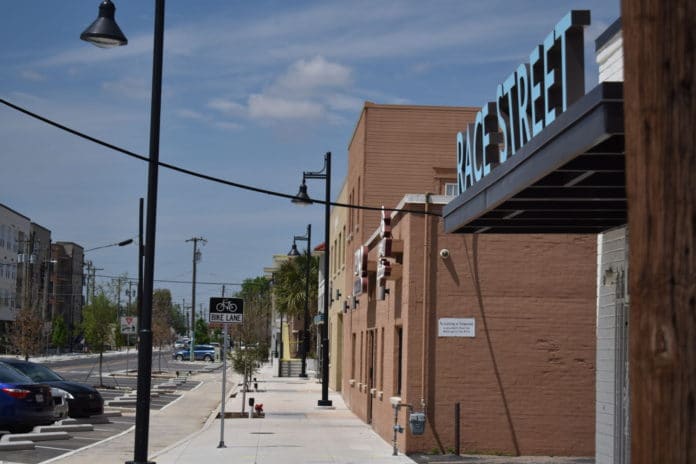All the dirt is now covered, the large pieces of machinery that roamed the streets are long gone and two parallel yellow lines dividing traffic have now replaced the long-standing traffic cones on Race Street, about two miles east of downtown Fort Worth.
Previously expected to be completed by March, the first phase of the city-led, multimillion-dollar streetscape improvements to Race Street is on its final stretch and just about finished, city officials said.
All the heavy road construction is done, but some landscaping and utility work remains to be completed, said Eric Fladager, planning manager at the city’s Comprehensive Planning Section.
Race Street’s revitalization project — also referred to as Six Points Urban Village — received about $1.5 million in federal grants and over $4 million from the 2014 city bond funds. About $2.4 million from the Federal Highway Administration is also being used.
Originally designated in 2005, Six Points Urban Village is one of 16 Fort Worth urban villages, which are zoned for dense, multiple-use development to revitalize older commercial districts and re-establish them as appealing alternatives to generic suburban sites.
Phase one improvements at Six Points Urban Village include widening sidewalks, new on-street parking, pedestrian lighting, protected bike lanes, decorative pavements, street markings and public art displays.
This phase covers improvements along Race Street stretching more than 3,000 feet from Grace Avenue to Riverside Drive.
The second phase will see street improvements westward up to Oakhurst Scenic Drive that meets the Trinity River.
The whole project is estimated for completion within the year.
“This streetscape project is designed to create a pedestrian-friendly, walkable urban environment that’s safe for pedestrians and attractive for businesses,” Fladager said. “The goal is to draw people to Six Points Urban Village, in order to make it a destination that will attract people from throughout the region.”
Various local businesses have opened stores and offices in the area in the last few years. An ice cream shop, a barber shop, a music record store, a grocery store, several restaurants and cafes along with several other businesses currently operate on Race Street.
In that mix of businesses-owners is investment adviser James Blake, who along with his partner bought a building on Race Street in 2016. Blake’s commercial real estate brokerage firm, SVN Trinity Advisors, moved into the building in November 2016.
He said he is happy with the ongoing street improvements.
“What we really enjoy is having our business in a very walkable neighborhood and knowing the other business owners up and down the street,” Blake said.
The building the duo bought has three other tenants, making it 100% occupied.
“Basically, we moved to the area due to its central location,” Blake said. “Our company has 18 people and this is centrally located with employees and agents coming from Granbury, Denton, Keller, Decatur, Arlington. I have watched the area for a number of years and knew the city designated this as their next urban village, Six Points, with city funds to improve the street with parking and landscaping.”
The designation and street improvement projects have garnered interest from developers around the Dallas-Fort Worth area.
Dallas-based Aberg Property Co. and Corsair Ventures announced last October their plan to construct a 140-unit Class A apartment complex at the intersection of Race Street and Oakhurst Scenic Drive.
Criterion Development Partners, which has a development portfolio that exceeds $1 billion, recently built two apartment complexes in the area. Both are open and leasing to new residents.
“The new apartments, family housings that have been constructed on Race Street, there’s new restaurants, new businesses going in all the time,” said Randle Harwood, Fort Worth planning and development director. “And there’s more and more of that to come. The revitalization efforts are working extremely well for us for a fairly small amount of public capital.”






